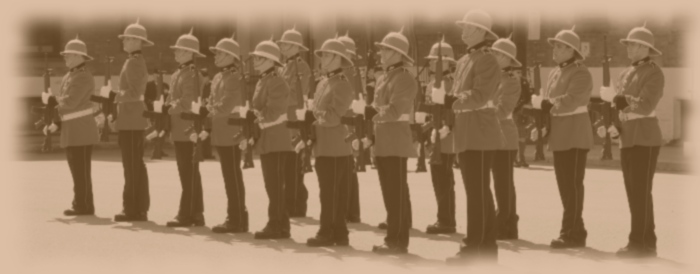Topic: Discipline

In Defence of "Spit and Polish"
Canadian Army Training Memorandum, No 62, May 1946
Canada is now engaged in the vital task of building a vigorous, streamlined army. One of the best methods of encouraging the right type of recruit is to impress upon him the smartness of the King's uniform and that means that every person now in uniform must be the acme of smartness in dress and bearing. Every officer should know his dress regulations and be able to instruct his men in them.
"I have heard it said that battles are not won on the parade ground. This is most untrue. `Spit and polish' is both a means and an end. It is the means of acquiring true discipline, morale and esprit de corps and it is the outward manifestation by which their presence is readily recognized and felt. It is not `eye wash', no mere frivolity, for it lives with the soldier in bivouac, marches with him in the field and bolsters his determination on the day of battle."
This statement was made by a U.S. Infantry officer in an article appealing for adequate recognition for the Infantry Corps. And it is timely. A Canadian officer has only to look about him to notice an ever-increasing untidiness in army dress. It can be explained, of course, by the fact that men in uniform now feel that because the battle is over, there is no longer any need to be quite so smart in their appearance, that they can relax. It can be explained — but it cannot be excused!
Those interested in the term "spit and polish" will find that it originated with the British soldier's traditional use of a little bit of "spit" and a lot of "polish" to bring boots and buttons to brilliance. Don't run away with the idea that this was primarily parade ground technique. "Spit and polish" also went with the British soldier into battle. The great captains of history realized that cleanliness, neatness and smartness went hand in hand with discipline in the making of a good soldier.
There has been considerable criticism by the public of the appearance of servicemen, particularly on the streets. This criticism dates from the end of the war. It was not vocal for a few months, citizens, in the main, taking the view that members of the Armed Forces deserved a hard-won opportunity to relax. Then things got worse. Many men began to look very untidy indeed! One of the most noticeable breaches of dress regulations was the appearance of men strolling along without head-dress; others included tunic collars open and no ties; pocket flaps open and pens and pencils showing; tunics and blouses unbuttoned an the way to the bottom; gaily-coloured socks worm with battle-dress; dirty brass and webb — the list is almost endless and covers dress from beret to boots.
It's an unpleasant picture — and a picture for which officers are in large part responsible. How many times have YOU walked along the street, noticed flagrant breaches of dress regulations and yet done nothing about it? You can't defend yourself by arguing that it's a job for the M.P.'s; it's primarily your responsibility — a responsibility you accepted when you received your commission.
Our army is only as good as its men. Trite but true. We can hardly say that the man is only as good as his dress, but we can say that a man is only as good as his discipline. Discipline is bound up with dress; discipline is a combination of alertness, cleanliness and a smart uniform.
The "show window" of the Canadian army is its dress. And it's the "show window" that the public sees. To them a slovenly soldier means a slovenly army.
To illustrate further: On VJ Day, CATM went about designing a cover for its next issue. It was to be dedicated to the private soldier who had played such a large part in winning the war. The artist sketched a soldier flushed with victory — and a two-day growth of beard. The editor submitted the sketch, for approval, to an officer who had commanded troops in battle.
"Fine", said the officer. "But why the beard?"
"Well, we thought … he's just come out of battle, sir."
"Battle, nothing! Whenever humanly possible, I saw to it that my men shaved — every morning — battle or no battle. That was in Italy, and I discovered that they felt better for it. A clean soldier makes a better fighter. You never saw a Canadian soldier with a stubble like that, even in action, if he had a commander worth his salt. Take his beard off!"
All ranks should be consciously proud of the King's uniform. It is the outward sign that they belong to the best and bravest profession. Fighting garb is a part of esprit de corps.
Canada is now engaged in the vital task of building a vigorous, streamlined army. One of the best methods of encouraging the right type of recruit is to impress upon him the smartness of the King's uniform and that means that every person now in uniform must be the acme of smartness in dress and bearing. Every officer should know his dress regulations and be able to instruct his men in them.
Remember: "Spit and polish" still plays its part in discipline and esprit de corps. "Spit and polish" by itself never won a war, but it is one of the biggest single factors in making soldiers who will.

